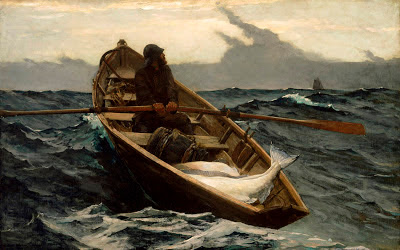 |
| The Fog Warning (1885) |
In Winslow Homer’s painting The Fog Warning (1885) he paints
a halibut fisherman that is racing against the clock of time. As you can tell
from the painting he has a large catch for such a small boat. Perhaps he stayed
out just a touch too long in his effort to maintain his livelihood. To small
fishing boats a few large fish can make a huge difference in the lifestyle they
gain. There is a temptation to test the powers of nature in achieving one’s
goals. It is a picture that pushes one to see the how connected man is to
nature.
We can see that there is danger in the painting. The man is
on the sea, the winds are pushing him hard, the waves could capsize his
weighted ship. We can envision that the clouds are coming and a storm is
brewing. The man may have ignored the fog warning and decided to fish just a
little longer than was necessary. The goal of the painting is to stimulate nervousness
with the fisherman being alone fighting against the elements.
The fisherman is looking out over his shoulder trying to
judge whether or not he will make it to shore. There is no shore in site but
off in the distance is a ship. Hope! The clouds are coming and his boat is
bouncing. The dark colors and clothing of the painting show it is cold outside.
It is a painting of fear, loneliness, danger, and judgment. Its appeal is in
how the emotions are elicited in the viewer.
Winslow Homer was an American Painter who was well known for
his nautical and landscape paintings (1836-1910). He was a highly influential
painter in the 19th Century who started as a commercial illustrator
and then moved into oil painting. He was self taught and developed a skill
unique to him. He worked with both oil but also water colors which allowed for
a slightly different style in his productions.
Homer was born in Boston Massachusetts and took the skill of
his mother to another level. His father was a businessman who went through a
number of businesses, the gold rush and finally went to Europe to seek capital.
He left his family in search of greater glory. Upon Homer’s graduation his
father set him up in an apprenticeship that marks the beginning of Homer’s amazing
career.
In his work as an illustrator he contributed to important
magazines such as Boston Life and Harper’s Weekly. He studied one year at the
National Academy of Design and was sent to the Civil War to draw paintings. After
this time he worked on drawing paintings of simpler times for himself and the
nation. He drew family, children, livelihoods, and young women. His work was so
loved it made its way into a 1962 stamp.
Perhaps we should never ignore the fog warning!
No comments:
Post a Comment